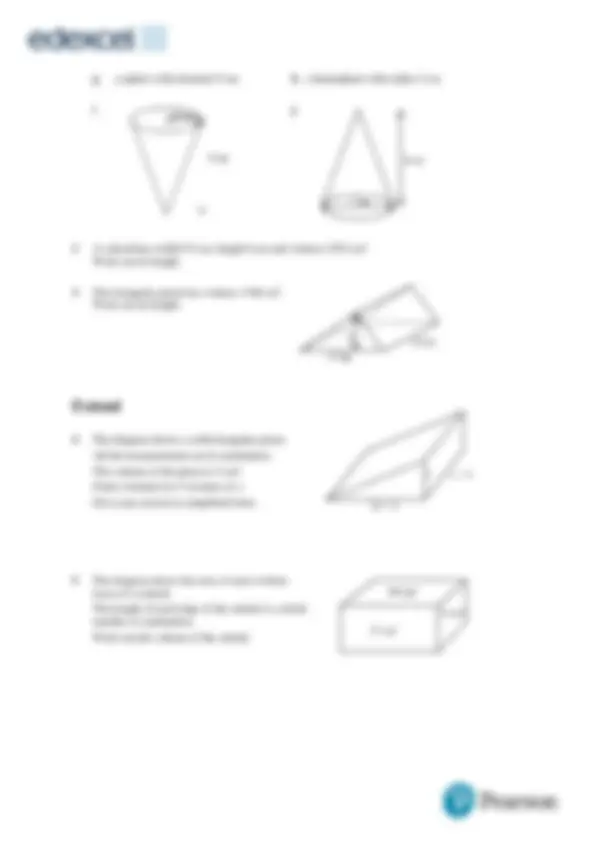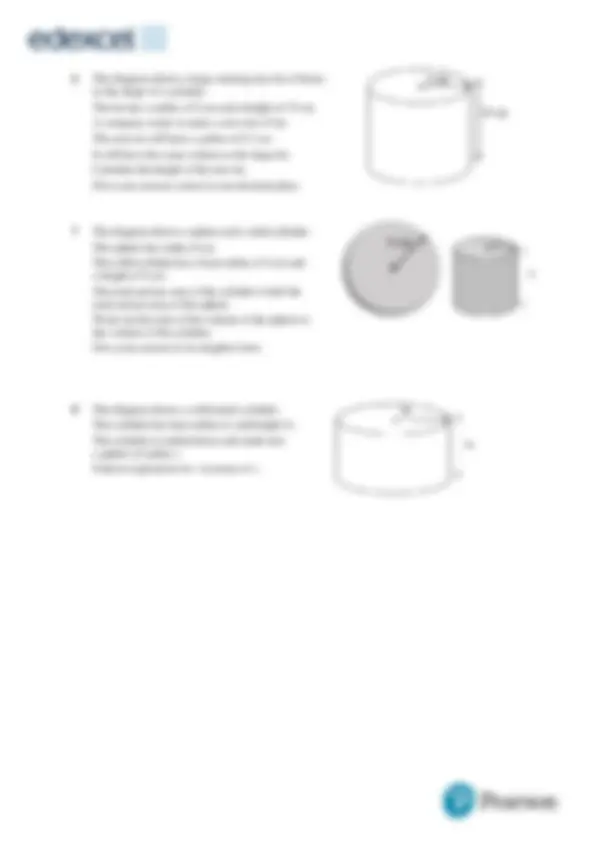





Study with the several resources on Docsity

Earn points by helping other students or get them with a premium plan


Prepare for your exams
Study with the several resources on Docsity

Earn points to download
Earn points by helping other students or get them with a premium plan
Community
Ask the community for help and clear up your study doubts
Discover the best universities in your country according to Docsity users
Free resources
Download our free guides on studying techniques, anxiety management strategies, and thesis advice from Docsity tutors
Volume of a prism = cross-sectional area × length. The surface area of a 3D shape is the total area of all its faces. × area of base × vertical height. Example ...
Typology: Lecture notes
1 / 5

This page cannot be seen from the preview
Don't miss anything!




Scheme of work: 6b. Gradients, tangents, normals, maxima and minima
r
Example 1 The triangular prism has volume 504 cm^3. Work out its length.
V = 12 bhl
504 = 12 × 9 × 4 × l
504 = 18 × l l = 504 ÷ 18 = 28 cm
1 Write out the formula for the volume of a triangular prism. 2 Substitute known values into the formula. 3 Simplify 4 Rearrange to work out l. 5 Remember the units.
Example 2 Calculate the volume of the 3D solid. Give your answer in terms of π.
Total volume = volume of hemisphere
= 12 of 4 3 πr^3 + 1 3 πr^2 h
Total volume = 12 × 4 3 × π × 53
1 3 × π × 52 × 7
=
425 3 π cm^3
1 The solid is made up of a hemisphere radius 5 cm and a cone with radius 5 cm and height 12 − 5 = 7 cm.
2 Substitute the measurements into the formula for the total volume.
3 Remember the units.
Practice
1 Work out the volume of each solid. Leave your answers in terms of π where appropriate.
a b
c d
e f a sphere with radius 7 cm
6 The diagram shows a large catering size tin of beans in the shape of a cylinder. The tin has a radius of 8 cm and a height of 15 cm. A company wants to make a new size of tin. The new tin will have a radius of 6.7 cm. It will have the same volume as the large tin. Calculate the height of the new tin. Give your answer correct to one decimal place.
7 The diagram shows a sphere and a solid cylinder. The sphere has radius 8 cm. The solid cylinder has a base radius of 4 cm and a height of h cm. The total surface area of the cylinder is half the total surface area of the sphere. Work out the ratio of the volume of the sphere to the volume of the cylinder. Give your answer in its simplest form.
8 The diagram shows a solid metal cylinder. The cylinder has base radius 4 x and height 3 x. The cylinder is melted down and made into a sphere of radius r. Find an expression for r in terms of x.
Answers
1 a V = 396 cm^3 b V = 75 000 cm^3 c V = 402.5 cm^3 d V = 200 π cm^3 e V = 1008 π cm^3 f V=^13723 π cm^3 g V = 121.5 π cm^3 h V = 18 π cm^3 i V = 48 π cm^3 j V = 983 π cm^3
2 17 cm
3 17 cm
4 V = x^3 + 172 x^2 + 4 x
5 60 cm^3
6 21.4 cm
7 32 : 9
8 r =^3 36 x